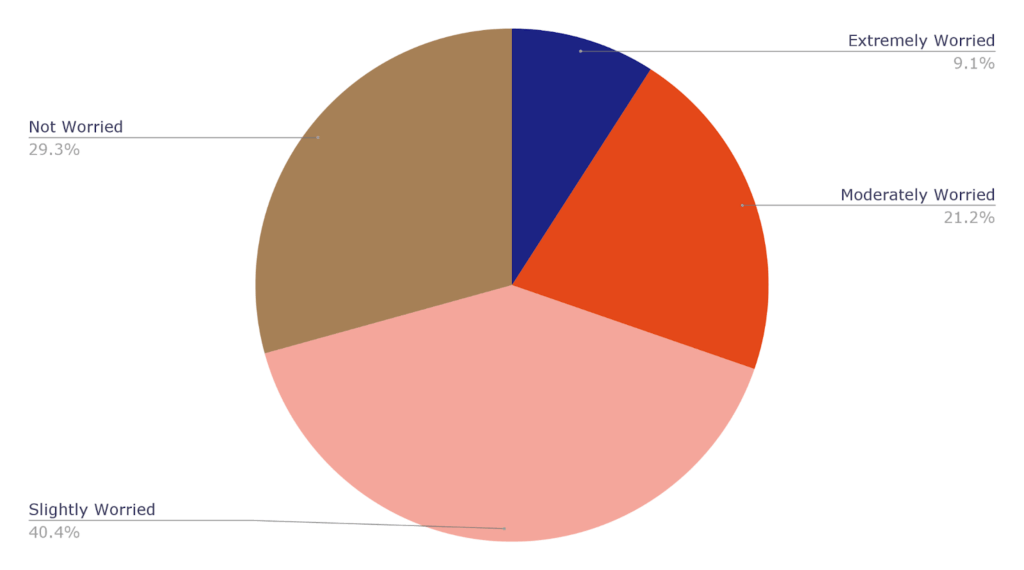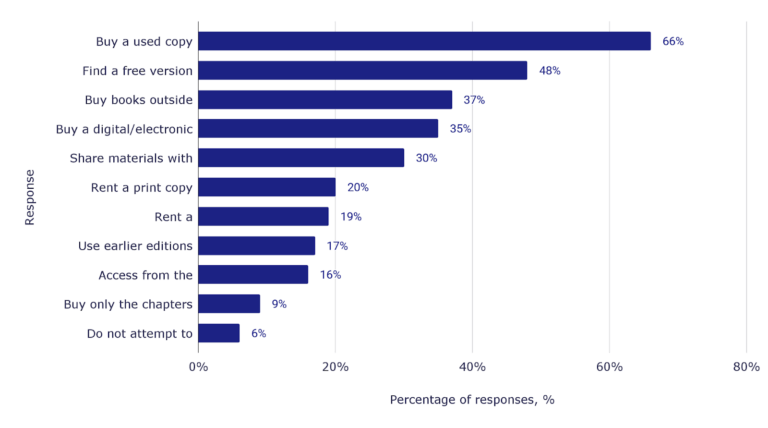Key findings:
Students at four-year colleges spend an average of $1,290 per year on books and supplies in 2024-25, compared to $1,520 at two-year schools; a gap that has widened by nearly $230 since 2010.
The average cost of a college textbook remains high, with new print editions priced between $100 and $300, and used copies 20-50% cheaper.
Nearly 30% of students report being moderately or extremely worried about textbook costs, underscoring the ongoing financial pressure of course materials.
To save money, 66% buy used books and 48% find free versions online, reflecting a nationwide shift toward cheaper, digital, and shared learning resources.
Renting and digital options help cut expenses, with Barnes & Noble and Chegg offering rentals from $18-$19, and e-books priced between $40 and $150.
The average cost of a college textbook has long been a concern for students, parents, and educators alike. As tuition and housing expenses continue to rise, the price of course materials remains a major part of the financial burden of higher education. Recent data shows that college students in the U.S. spend hundreds of dollars each year on textbooks and supplies, even as digital access and rental options become more common. Understanding how much college books cost and what drives these prices is key to making smarter financial and academic decisions.
Average annual cost of books and supplies for college students in 2024-25
The chart below compares the average cost of books and supplies for college between four-year and two-year institutions from 2010-11 to 2024-25. It highlights how books and supplies for college have fluctuated over time, reflecting broader trends in educational affordability. While costs have remained relatively stable at four-year institutions, two-year schools have experienced a more noticeable increase in recent years.
- In the 2024-25 academic year, students at four-year institutions spend an average of $1,290 on books and supplies, compared to $1,520 at two-year institutions.
- Since 2010-11, the cost of books and supplies for two-year institutions has risen by about 17%, while four-year institutions saw a smaller 5% increase over the same period.
- The gap in spending between two-year and four-year colleges widened from $79 in 2010-11 to $230 in 2024-25.
How much do college books and supplies cost per year by school type?
Overall, the average books and supplies cost for college continues to be a significant financial factor for students. Despite modest fluctuations, expenses for textbooks and materials remain over $1,200 per year for most students, showing limited progress in cost reduction. The persistent rise at two-year institutions suggests that even community college students face increasing financial pressure related to books and supplies for college. These findings emphasize the ongoing importance of affordable textbook options and open educational resources to help ease the financial burden on students.
After understanding the general trends in the cost of books and supplies, it’s equally important to examine how textbook prices differ depending on a student’s field of study.
The average cost of college textbooks by field of study in 2022-23
The following chart shows the average cost of college textbooks across different academic disciplines during the 2022-23 school year. It highlights how the average price of a book varies significantly between majors, with some programs requiring far more expensive materials than others. This comparison underscores how a student’s chosen field can greatly affect their personal expenses for college students.
- Students in political and law-related fields faced the highest textbook expenses, spending an average of $389 per year.
- The most expensive college textbooks were also common in health and business programs, averaging $383 and $378, respectively.
- Mathematics majors had the lowest average textbook cost at just $174, nearly 55% less than students in law-related disciplines.
How much does a college book cost by major?
- New print textbooks typically cost between $100 and $300 per book.
The data reveal a substantial gap in the average textbook cost among different fields of study. Programs that rely heavily on specialized or frequently updated materials, such as health sciences, business, or law, tend to have higher college book prices. In contrast, disciplines like mathematics and the physical sciences often use lower-cost or reusable resources. These variations highlight the importance of considering field-specific expenses when assessing the average cost of books and the overall affordability of higher education.
Beyond differences by institution or field of study, it’s also useful to look at how much individual students actually spend on course materials in a typical academic year.
The average spending on course materials among college students
The chart below illustrates the distribution of average spending on course materials among college students. It shows how students’ financial commitment to textbooks and learning resources varies widely, with some paying very little while others face substantial expenses. This breakdown provides valuable insight into how unevenly the average cost of a textbook impacts students across income levels and study programs.
- 31% of students reported spending more than $300 on course materials during the academic year.
- About 26% spent between $101 and $200, making this the most common spending range.
- Only 7% of students managed to complete their courses with no textbook costs at all.
How much do college students spend on course materials?
The data show that a significant share of students still face high costs for course materials, with nearly one in three spending over $300 per year. Although a minority report minimal or no costs, likely due to digital access or open educational resources, the average cost of college textbooks remains a major expense for many. These findings underline the continuing need for affordable and accessible course materials to reduce financial barriers in higher education.
After looking at how much students spend on course materials, it’s worth examining how these costs affect their financial stress and sense of security throughout the semester.
How worried are college students about textbook costs in 2023?
The chart below reveals how concerned students were about paying for course materials during the 2023 term. It offers insight into why college textbooks cost so much has become a pressing issue among students nationwide. As the average cost of a textbook continues to rise, many learners are forced to budget carefully, seek secondhand materials, or look for ways to save money on college textbooks.
- Nearly 30% of students reported being either moderately (21%) or extremely worried (9%) about affording their course materials.
- The largest group, 40% of students, said they were slightly worried, showing that textbook prices cause at least some concern for most learners.
- Only 29% of students reported not being worried at all, suggesting that high textbook costs remain a widespread source of financial pressure.
Why are college textbooks so expensive, and how do students feel about it?
The findings make it clear that students remain anxious about how expensive college textbooks have become. Even though not all are deeply affected, the fact that more than two-thirds experience some level of concern highlights the ongoing problem of affordability.
Given the number of students who worry about textbook affordability, it’s essential to examine the practical steps they take to mitigate these expenses throughout their studies.
How do college students reduce the cost of course materials?
The chart below shows the strategies students use to cut down on textbook and material costs during college. As college textbooks are so expensive, many learners look for creative and budget-friendly alternatives. From buying used copies to finding free versions online, students are actively adapting their purchasing habits to manage the high cost of course materials.
- The most common strategy is to buy a used copy, chosen by 66% of students to save money on college textbooks.
- Nearly half of students (48%) reported that they find free versions online, reflecting a growing reliance on digital resources.
- Only 6% said they do not attempt to reduce costs, showing that the vast majority take at least some measures to manage textbook expenses.
Ways students save money on college textbooks
These results illustrate that students are highly proactive in offsetting the high cost of college textbooks. Most rely on secondhand, digital, or shared resources rather than paying full price at campus bookstores. The popularity of options such as renting, accessing library materials, or using earlier editions underscores a larger trend toward affordability and sustainability.
After exploring how students try to save money on course materials, one of the most effective strategies to cut expenses is renting textbooks instead of buying them.
College book rentals: comparing prices across top platforms in 2025
The chart below compares the college book rentals market across several leading platforms. It shows the starting rental price for textbooks from major providers, offering insight into where you can rent books for college at the most affordable rates. As textbook prices continue to rise, rental services have become a key solution for students seeking flexibility and cost savings.
- Barnes & Noble offers the lowest starting rental price at $18 per textbook, closely followed by Chegg at $19.
- Most college book rental services, such as Campus Book Rentals, eCampus, and Campus Books, start around $20, making them competitive options for budget-conscious students.
- Knetbooks is the most expensive among the listed platforms, with a base rental price of $25 per textbook.
Where can you rent books for college, and how much does it cost?
- Rental prices depend on the textbook subject; STEM books generally have higher rates, sometimes reaching $64-$89 per book for the semester
The comparison shows that renting textbooks can dramatically reduce college costs, especially when students choose platforms offering lower entry prices. With most services priced between $18 and $25, renting is often far cheaper than purchasing new or even used books. Understanding the best textbook rental sites helps students make informed decisions and optimize their spending throughout the semester. As demand for college book rentals continues to grow, competition among these platforms is likely to improve pricing and accessibility for students further.
While renting textbooks offers one way to save, students can also choose among other options, such as buying used college textbooks or switching to ebooks for college, to manage their expenses more efficiently.
Comparison of college textbook prices: new, used, rental, and e-book options
The chart below compares the price range for various textbook options, including new print, used college textbooks, ebook college textbooks, and rentals. It highlights the cost difference between traditional and digital formats, showing how cheap college textbooks are increasingly accessible through used or electronic versions. For students wondering where to buy used college textbooks or how much renting textbooks costs per month, these comparisons provide a clear overview of affordability.
- New print textbooks remain the most expensive option, priced between $100 and $300 per book.
- Used print copies typically cost between $70 and $210, making them one of the most popular choices for students seeking cheap used college textbooks.
- E-books and rentals are the most affordable, with e-book college textbooks priced from $40 to $150 and rental options starting as low as $20 (or $64-$89 for STEM subjects).
Cheap college textbooks: how prices differ across buying and rental options
- Used print books typically cost 20-50% less than new editions, offering a reliable way to cut textbook expenses.
- E-textbooks are priced between $40 and $150, with variations depending on licensing terms and included digital features.
The data clearly show that students can save substantially by choosing used college textbooks or ebooks for college instead of buying new copies. The rise of online textbooks for college and e-textbook platforms has expanded access to learning materials while keeping costs manageable. With the average ebook cost often less than half that of a new print edition, digital formats are becoming a practical alternative for cost-conscious learners. Ultimately, comparing all these options helps students find the cheapest college textbooks and make informed financial decisions throughout their studies.
Conclusions
- By 2024-25, the cost of college textbooks and supplies remains a persistent burden for U.S. students, averaging $1,290 at four-year institutions and $1,520 at two-year colleges. Despite modest progress in expanding digital and rental access, textbook prices highlight the limits of affordability initiatives in higher education.
- Textbook expenses also vary sharply by academic field, creating uneven financial pressure across majors. Students in law, health, and business programs face costs more than twice as high as those in mathematics or physical sciences, reflecting both market pricing and the need for frequently updated specialized materials.
- Affordability concerns have become a defining feature of college life. Nearly 30% of students report being moderately or extremely worried about paying for course materials, and only 29% feel no concern at all. This widespread anxiety underscores how even non-tuition expenses can shape the student experience and influence persistence in college.
- Students are increasingly resourceful in managing these costs. A majority now buy used copies (66%) or find free versions online (48%), while rentals starting as low as $18 per book have turned into a mainstream alternative. These shifts suggest a structural transformation in how students access learning materials away from traditional bookstore purchases and toward flexible, low-cost, and digital solutions.
Sources
- Average Total Cost of Attendance for First-Time, Full-Time Degree/Certificate-Seeking Undergraduate Students in Degree-Granting Postsecondary Institutions, by Control and Level of Institution, Living Arrangement, and Component of Student Costs: Selected Academic Years, 2010-11 through 2022-23. https://nces.ed.gov/programs/digest/d23/tables/dt23_330.40.asp. Accessed 14 October 2025.
- Bailey, Alison. “9 Best Places to Rent Textbooks in 2025 – BookScouter Blog.” BookScouter Blog, 21 Apr. 2025, https://bookscouter.com/blog/places-to-rent-textbooks/. Accessed 14 October 2025.
- Lyss Welding Updated on June 24, 2025, Edited. “Average Cost of College Textbooks: Full Statistics | BestColleges.” BestColleges.Com, 24 June 2025, https://www.bestcolleges.com/research/average-cost-of-college-textbooks-statistics/. Accessed 14 October 2025.
- Zinn, Dori. “Average Cost Of College 2024-2025 | Bankrate.” Bankrate, 1 Nov. 2023, https://www.bankrate.com/loans/student-loans/average-cost-of-college/. Accessed 14 October 2025.
- https://www.bayviewanalytics.com/reports/2023_student_course_material_affordability.pdf. Accessed 14 Oct. 2025. Accessed 14 October 2025.
- https://thecollegeinvestor.com/16864/college-textbook-rental-comparison/. Accessed 14 October 2025.
- https://www.collegeave.com/articles/how-much-are-college-textbooks/. Accessed 14 October 2025.














